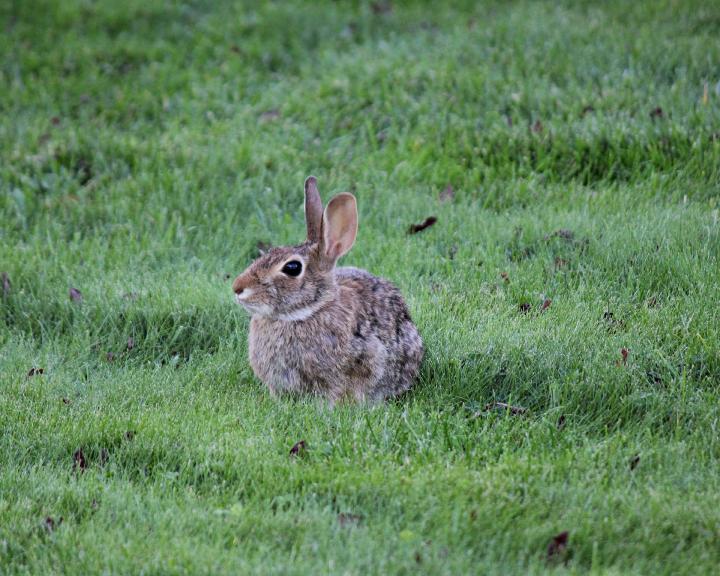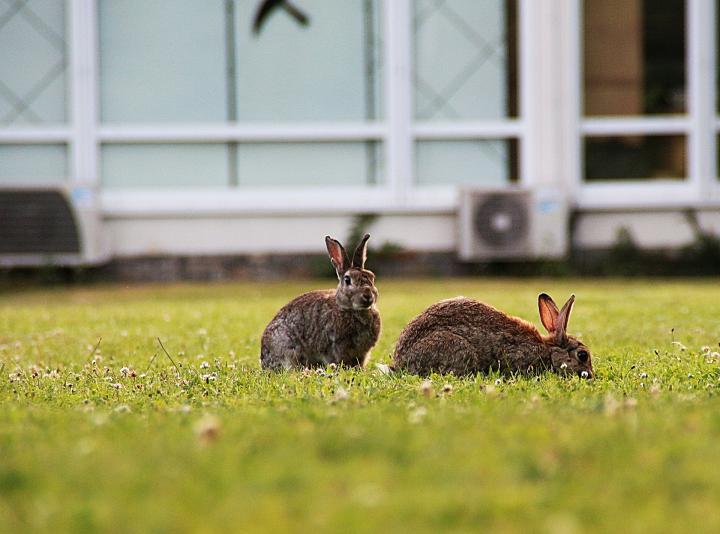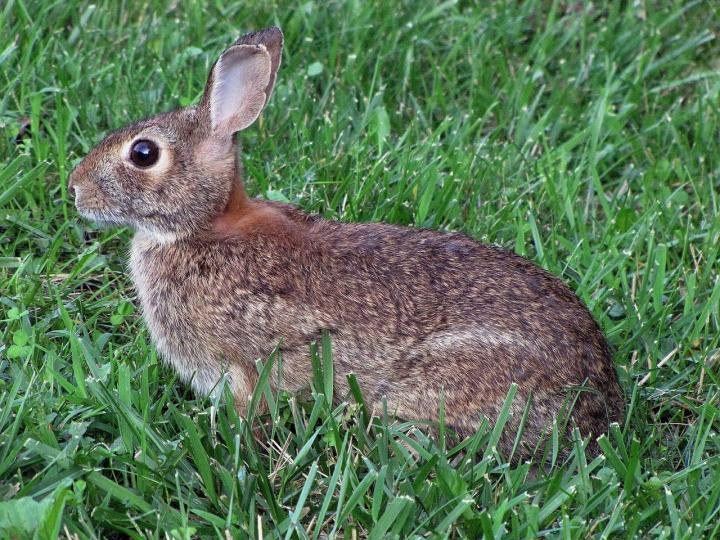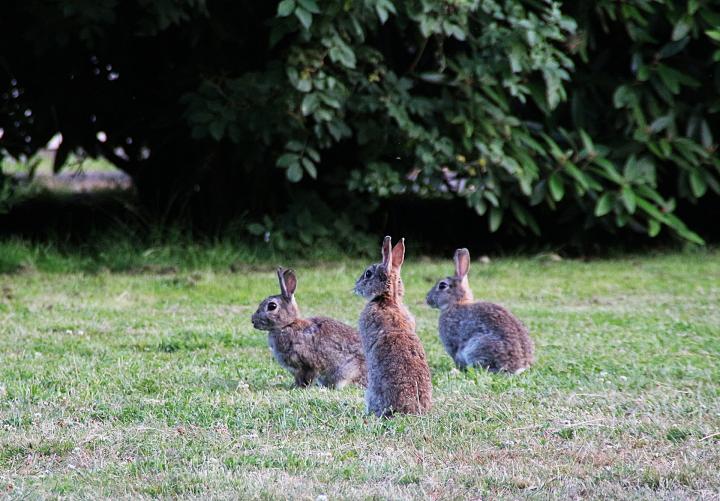






Learn how to get rid of rabbits and keep them out of your garden with these tips.
Anyone who tills the soil regards the rabbit as more than a cute threat to the carrot patch. This long-eared animal possesses a voracious appetite for all kinds of fresh vegetation—woody plants, perennials, annuals, vegetables, and berries. In fact, a menu of rabbit favorites is so ridiculously long that it’s easier to list the few plants they don’t enjoy.
Rabbits also have an extremely high reproductive potential, which is why keeping them around might quickly cause a total garden infestation. They reach up to three litters of six babies each per year in the north, and up to six litters of three babies each per year in the south. The first litter appears in March in the north, year-round elsewhere. The gestation period is 29 days.
Your backyard bunny’s primary concern is to eat without being eaten, a difficult task given that rabbits are relished by more than two dozen species of predators. Nibbling your petunias is therefore not a carefree picnic but a danger-fraught mission. However, if your neighborhood bunny can squeeze through a hole in your garden fence, it will be able to munch in safety.
You can check our tips for keeping your plants safe from rabbits, but try to regard rabbits as Beatrix Potter did—part of a peaceful, pastoral landscape. Then protect the plants that you and the bunnies really love, and don’t worry about the rest.

Of the nine species of North American cottontail rabbits, it’s the eastern cottontail (Sylvilagus floridanus) that is our most abundant and annoying. Ranging from Boston to Boulder and south into Mexico, this bunny-about-town is rarely found in forests; preferring instead brushy fence rows, field edges, brush piles, and—you guessed it—landscaped backyards. Its fondness for flowers, vegetables, bark, and bulbs often results in pruned peppers and clipped cosmos.
Even though its nicknames are adorable (among them bunny, bunny rabbit, and cottontail), and you’ll probably want to befriend it once you see its cute ears, the eastern cottontail can be a bothersome pest. It is gray or brownish, with a short tail and big ears. It can weigh 2 to 4 pounds, be 15 to 19 inches in length, and live for 12 to 15 months. Its vocal call is almost silent, but it will emit a scream when threatened. Its famous features include a short white tail resembling a cotton ball and long tapered ears.
For an eastern cottontail, security is a pile of brush, leaves, or another animal’s abandoned burrow. Unlike their European cousins, these rabbits do not dig intricate burrows or warrens but make due with what they find. Rabbits rarely leave their shelters in broad daylight, preferring instead early morning or evening. Like most animals, they are sensitive to the change in day length as spring approaches. For rabbits, the longer days signal the start of two things: breeding season and spring dining.
Rabbits are voracious eaters and leave clean-cut damage. Check the leaves and stems of your plants for cleanly cut damage; insects and other pests usually leave jagged edges on damaged plants. This clean-cut damage often happens at ground level, as rabbits tend to eat the yummy green shoots of tulips and other plants.
These low mowers graze close to the ground and sniff out the first tender young shoots and crop them short. They love to munch on flowers, clover, peas, lettuce, beans, and more. Many of these plants are also the favorites of woodchucks or groundhogs, so check for burrows before deciding you have rabbit damage. Once your plants have passed the seedling stage, they are usually safe from rabbit damage.
Although bunny nibbling occurs in every season, it’s especially discouraging in the early spring when rabbits mercilessly munch the tender green shoots of plants. As a Connecticut gardener remembers, “My tulips were just poking through the snow when suddenly it looked like they’d been weed-whacked. Cut clean off! I blame the bunnies—their little paw prints were everywhere.”

Though we’ve mostly been discussing eastern cottontails, keep in mind—these tips should work for any type of rabbit that loves to munch on your plants!

The best way to keep rabbits out of the garden is to start early in the spring using the things they don’t like, then be consistent throughout the growing season.
According to bunny experts, rabbits have plant preferences based on taste, nutritive value, the presence of poison or prickles, and ease of availability. Their tastes in food can also vary by region and season, so not all plants work for all rabbits. Be tricky and tend plants that rabbits don’t find very appetizing.
Rabbits tend to avoid some of the same plants as deer and Japanese beetles. If you’d like to control all these pests, check our list of deer-resistant plants and best and worst plants for Japanese beetles to know which plants might do best. Choose plants such as forsythia, lilac bush, marigolds, zinnias, daffodils, lavender, and snapdragons for rabbits. This might help to reduce your rabbit population. This is not a guaranteed solution, as hungry rabbits will eat almost anything, but filling your garden with these plants might make your garden less appetizing than another one. Here are more plants that rabbits dislike:
Azalea (Rhododendron sp.)
Boxwood (Buxus sp.)
Bush cinquefoil (Potentilla fruticosa)
Butterfly bush (Buddleia davidii)
Cotoneaster (Cotoneaster sp.)
Japanese maple (Acer palmatum)
Mountain laurel (Kalmia latifolia)
Rhododendron (Rhododendron sp.)
Tatarian dogwood (Cornus alba)
Tulip tree (Liriodendron tulipifera)
Adam’s needle (Yucca filamentosa)
Creeping phlox (Phlox subulata)
Foam flower (Tiarella cordifolia)
Lamb’s ear (Stachys byzantina)
Meadow rue (Thalictrum rochebrunianum)
Peony (Paeonia hybrids)
Perennial salvia ‘East Friesland’ (Salvia x superba)
Primrose (Primula x polyantha)
Russian sage (Perovskia atriplicifolia)
Sedum ‘Autumn Joy’ (Sedum)
Speedwell (Veronica sp.)
Spring cinquefoil (Potentilla verna)
Stokes’ aster (Stokesia laevis)
Four o’clock flower (Mirabilis jalapa)
Geranium, zonal and bedding (Pelargonium x hortorum)
Mexican ageratum (Ageratum houstonianum)
Pot marigold (Calendula officinalis)
Spiderflower (Cleome hasslerana)
Vinca (Catharanthus roseus)
Wax begonia (Begonia x semperflorens-cultorum)
Daffodil (Narcissus sp.)
Hyacinth (Hyacinth orientalis)
Persian onion (Allium giganteum)
Asparagus
Leeks
Onions
Potatoes
Rhubarb
Summer squash
Tomatoes
Basil
Marjoram
Mint
Oregano
Parsley
Savory
Tarragon
Do you have any tips for controlling rabbits in your garden or yard? Please post below!
How to Get Rid of Garden Inchworms
Anthracnose: How to Identify, Control, and Prevent Anthracnose
Cabbage Root Maggots: How to Identify and Get Rid of Garden Pests
Mexican Bean Beetles: How to Identify and Get Rid of Garden Pests
Squash Vine Borer: How to Identify and Get Rid of Garden Pests
Moles: How to Identify and Get Rid of Moles in the Garden or Yard
Squirrels: How to Identify, Control, and Get Rid of Squirrels in Your Garden
Copyright © www.100flowers.win Botanic Garden All Rights Reserved